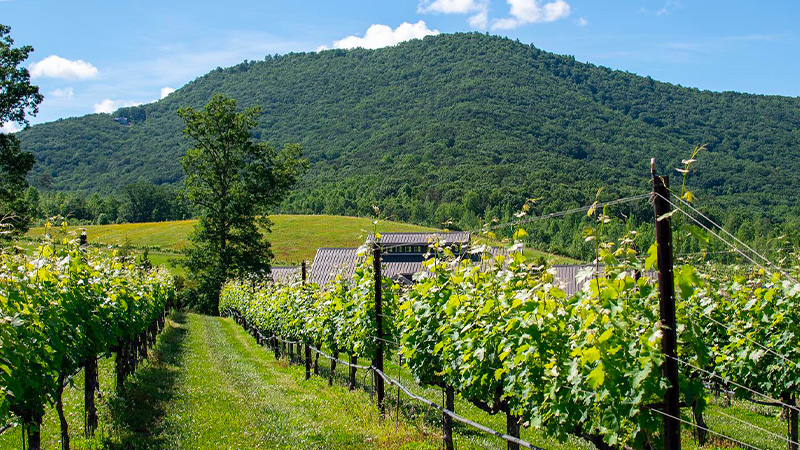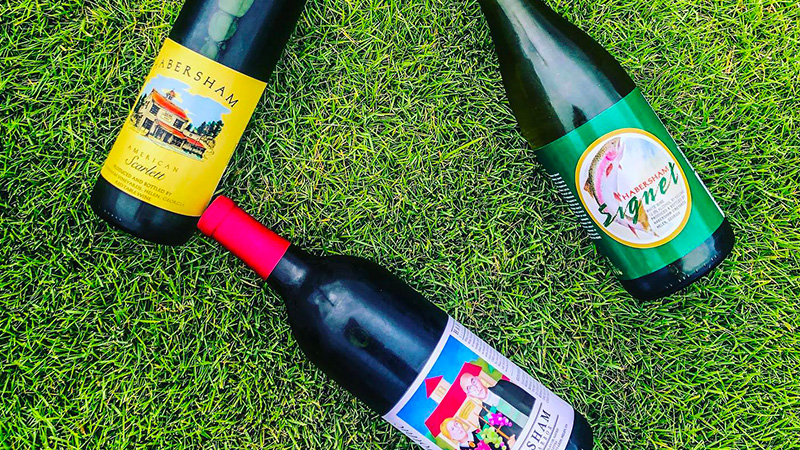When Georgia is mentioned in wine-centric circles, the discussion is usually centered on the Eastern European nation, where the traditional clay amphora fermentation process is the stuff of reverent legends. But the conversations about our own Georgia here in the U.S.A, though, consistently run dry.
By 1880, Georgia was the sixth-largest winegrowing state in the country, with over 20,000 acres of land devoted to grapes. But the Peach State’s wine dreams died on the vine when Prohibition swooped in early: Alcohol became illegal in the state in 1907, over a decade before it became a national edict in 1920. This legislation also overstayed its welcome and wasn’t given the boot until two years after the rest of the country repealed the 19th Amendment. Combined, this created one of the longest state-wide dry spells in the country.
But today, the wine industry in Northern Georgia is making up for lost time, and catching up quickly.
Don’t Miss A Drop
Get the latest in beer, wine, and cocktail culture sent straight to your inbox.
Muscadine’s Moment
California has robust Cabernet Sauvignon, Oregon prized Pinot Noir, and Long Island helped to usher in the golden age of rosé. But Georgia? It’s become known for its state grape: the all-American Muscadine, a prolific grape indigenous to the American Southeast with a propensity for late-summer aromas and flavors beneath bitter skin.
“There’s no one Muscadine,” says Jane Garvey, a founding member of the Georgia Trustees Wine & Spirits Competition. “There are over 300 cultivars; someone is going to tell you they all taste alike. They do not.” But what these wines do have in common is that they can often be affordable, extra fruity, and almost syrupy sweet — characteristics that have earned it derision in popular wine culture.
“Muscadine is hard to sell [as] not sweet. When it’s dry, it tends to be bitter,” says Craig Boyd, the winemaker for Georgia’s oldest and largest winery, Habersham Winery. He arrived there with over 30 years of industry experience, but in his two years at the helm, he’s learned that there are inherent biases around the grape.
“That’s the established palate for it – people expect it to be sweet,” he explains. “They’ll say, ‘Grandpa made it in the basement and it was always sweet.’”
Henna Bakshi, a WSET Level 3-certified wine journalist and expert, agrees. “For a while, people in Georgia didn’t have a lot of contact with other wines; it’s a regional preference. Think about how popular sweet tea is here,” she points out. She adds that the extra warmth of the region gives the wine an already sweet tilt.
“I think they’re making it more carefully … and in a variety of styles. It’s grown from being something that was more homegrown.”
“The higher the temperatures, the riper the grapes can get,” she says. “The [grapes] already have a high sugar content and low acidity, so when you ferment them, they’ll already have a high sugar content without adding any to the wine,” the latter being a practice some Georgia Muscadine growers will employ to counter the bitterness of the skins.
But times are changing, and so is the wine coming out of Georgia. While white Muscadine is still one of Habersham’s top sellers, the bottles themselves are growing more complex.
“There is definitely a shift with native grapes. It’s on the sweeter end, but not as sweet as it used to be,” Bakshi says.
In Garvey’s expert opinion, it’s straight-up getting better. “I think they’re making it more carefully … and in a variety of styles. It’s grown from being something that was more homegrown.” Now, she says, the state is producing award-winning sparklers like those made by Jeanne Burgess of San Sebastian Winery.
Hills and Valleys
Despite Muscadine’s deep roots in Georgia’s identity, it’s not the only grape that can catch on there. In 1979, late legend Gay Dellinger of Cartersville’s now-shuttered Splitrail Vineyards successfully planted vinifera and French-American hybrids, proving that it could be done in North Georgia. Since then, others have followed, first slowly and then in an explosive wave over the last decade, according to Charles Ernst, owner of VIP Southern Tours, the first all-inclusive wine tour company in North Georgia.
“Our soil is perfect for the grapes we grow,” says Bob Miller, co-owner of Yonah Mountain Vineyards, which doesn’t produce Muscadine wine at all. “We have the diurnal temperatures that allow the higher-quality grapes, like in California, and we have a breeze, which dries out the leaves.”

“Plus, our latitude in North Georgia is the same as the southern Mediterranean — Italy, France, and near Morocco,” adds Jane Miller, fellow co-owner and Bob’s wife. “So we’re in a great grape-growing area.”
Still, it’s not always sunshine, and progress has been hard-won. “The bad thing is way too much rain,” Bob says. And while sloping hillsides with low erosion rates and decent drainage rates (depending on the part of the mountains) help, “it causes the plants to grow too fast,” he explains. And frost kills our varietals more easily; sometimes they ripen too late.”
Boyd says that out of his experience in New York’s Finger Lakes, South Dakota, California, and Arizona, “this is the hardest place I’ve ever been in my career to grow grapes. The disease and insect pressure is through the roof, the red clay soil is challenging, and it’s expensive.”
But this is where the next phase of North Georgia’s wine journey comes into play: the development and mastery of hybrids.
Grapes Bred for Bottling
Bakshi says she’s noticed a definite shift to hybrid varietals in the past 10 years as wineries and vineyards gain the reputation, experience, funding, and footing to experiment — and vouch for them as tried and true.
Lab-developed and land-perfected, “these types of grapes are so important for Georgia since there’s a lot of rain, a lot of water retention in the soil, disease pressure, mold, and frost to contend with,” she says. But when you have grapes that are bred to resist that, it’s going to flourish.” And the results, as Garvey will vouch, are spectacular.
“I’m so excited, so excited about these!” she says. “A lot of these hybrids trace their origins to France, but wine writers worry about what other wine writers think about them and [have] dissed them.” Garvey also says she believes climate change will make winemakers rethink their positions on these varietals, even in France, because they can handle the vicissitude of the climate better.
“I don’t think they’ll call embracing hybrids a new phenomenon. Instead, people will be catching up to us!”

That’s part of why Garvey thinks North Georgia is prime for more American Viticultural Areas (AVAs). “We share the first one with North Carolina, the [Upper] Hiwassee Highlands, and we just recently got the Dahlonega Plateau. The third one in the making is Elljay,” she says.
Of what’s making a splash, Chambourcin is a type often bandied about, credited with making Illinois rosé great. “It’s a nice, juicy red wine that’s jammy, a little country, and fruity — ideal for people who enjoy Merlot, Napa Cabs, and Syrah,” Bakshi says. It’s a particular favorite of Garvey’s as well, and a recent new planting on the Habersham grounds. Another hybrid Boyd is fostering at Habersham is Seyval Blanc, a grape he grew in upstate New York developed to mimic Sauvignon Blanc in all ways but its sensitivity to climate.
“It does well here; it’s pretty adaptable to warmer temperatures,” he says. “Occasionally, with a decent summer, it does end up being like a cold-weather Sauv Blanc.”
Leading in white wine hybrids in Georgia is Traminette, a cross between Gewurtztraminer and Seyval Blanc that Garvey says is the one she’s most excited to watch develop. It produces a wine that Bakshi describes as “gorgeous; very floral and bright with good balance to acidity, similar to Alsatian wines.” Another Seyval Blanc-derived mix is Chardonel, which — you guessed it — also boasts Chardonnay DNA.
“It’s got apple, pear, a little bit of honey mixed with Sauvignon Blanc-acidity, lemon, lime, green notes, and some white pepper. It’s perfect for those who like Chardonnay,” says Bakshi. But it can be a swing and a miss for makers who try to treat it the same way as a Chardonnay, Boyd warns. “It needs to be treated as itself.”
In future development, Boyd is looking into Villard Blanc for Habersham’s upmarket winery Creekstone. He jokingly calls it “a poor man’s Chenin Blanc” that “grows very well here,” and he’s looking forward to seeing how his experiments pan out.
The Grapes That Paved the Way
Of course, that doesn’t mean we ought to ignore the North Georgia wineries that ushered in the second wave of the region’s wine: the classic varietals of the Old World. (“I can’t stand that term; the so-called New World is several thousand years old,” Garvey says with an eye roll.) Yonah Mountain Vineyards exclusively grows these types, successfully harvesting five types of Chardonnay, Cabernet Franc, Cabernet Sauvignon, Petit Verdot, Merlot, Sauvignon Blanc, and Malbec on their farm.
“I grow the grapes I like,” Bob says. His son and general manager, Eric Miller, says with a chuckle: “We only grow the most difficult grapes there are to grow.” Because these varieties are more susceptible to frost and late ripening, yield is low. To counter that, many makers will bring in California grapes to add to their harvest. But it’s what they do with it that gives it those North Georgia roots.
There’s a sense of place and a thirst to prove that excellence is being pressed in these mountains. There’s a collective effort in North Georgia by winemakers, grape growers, and wine professionals to rise above the sugar-sullied reputation of the region. Education, they all agree, is the key. Ernst does his part by working with quality venues for his wine tours, partnering with the owners, winemakers, and sommeliers to offer tasting notes and change minds. Yonah matriarch Jane leads the movement behind the scenes as the current president of Georgia Wine Producers, an organization dedicated to supporting the education, marketing, and research of local viticulture and enology, as well as providing a forum to help growers work smarter, not harder, as they share the results of their experiments.
“The thing about emerging wine regions is that we all pretty much have to help each other,” Boyd says.” “It’s starting to happen here. We’re talking to each other about what’s working, what’s not working. … We need to band together — it lifts us all. If there are a few great wines and many are just OK, they won’t be impressed and might not come back. Having quality wine throughout the region makes all the difference.”